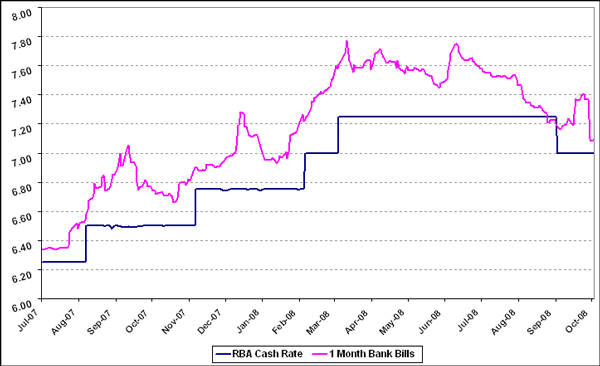Lack of trust among financiers is the core of our troubles as the great credit bubble of the past 30 years unwinds. Central banks have gone from being lenders of last resort to lenders of first resort. Market rates on liquid assets have been at a massive premium to the "official" rates set by central banks.
Our graph (see below) shows one such measure, for Australia, but in other places and with other measures, what we might call the "credit gridlock premium" is far wider.
This column has focused for six years on the setting of official rates, but this is a secondary matter at present. If the world's financial system is well managed, there will soon be a return to the standard focus on setting of official cash rates.
Advertisement
For now, keeping the world's financial markets functioning is the prime issue.
Central banks everywhere have been flooding markets with liquidity. Commercial banks have preferred to deposit spare cash with central banks than with their colleagues in other commercial banks. (Henry believes it is a universal human trait to judge others by one's own standards. Private bankers are mostly greedy, untrusting and lack courage. Their extreme defensiveness in this crisis is easily explained.)
In the US, Britain and Europe, banks have been nationalised or forced into hastily arranged marriages. Some, like Lehman Brothers, have simply filed for bankruptcy.
The Australian Prime Minister recently said that 25 banks worldwide had failed - he did not say "so far" but that was implicit.
A great debate is under way on the future regulation of private financial institutions. Henry hopes the resolution of this involves a return to the eternal verities of finance. Bankers lending only to good risks with truly valuable collateral. Asset managers buying only assets whose riskiness they know intimately. Retail customers remembering that the offer of high returns implies high risk, either because the assets backing retail products are genuinely risky or because the vendors are crooks.
When Germany was reunified, Henry asked a very senior (brown-eyed) Bavarian banker how he planned to check credit standards in the former East Germany. "We will look deep into their bright blue eyes and make a decision just as we used to do," the banker replied.
Advertisement
This man retired with every banking award it was possible to gather, and his record stood for many years. Low-tech, old-fashioned credit checks worked for him. A similar approach should work also for current bankers and their regulators.
It is sincerely to be hoped that financial system regulators do not try to turn bankers into bureaucrats micromanaging vast systems modelled on the controls that failed so decisively in the former East Germany and similar communistic states.
For the present, fear is locking financial markets far more effectively than even a mid-sixties communist regulator would have aspired to.
National treasuries and financial regulators need to work closely in concert to ensure there is no financial system failure, failed banks are dealt with more or less as they have been until all the problems are dealt with, and confidence and trust returns. A permanent reduction of the credit gridlock premium will be the most reliable sign that the situation is normalising.
What role will cuts in official cash rates play in all this?
Nothing much, it must be stressed. It might be thought that cuts to official rates might lead to lower market rates, but in an atmosphere where trust has evaporated, this cannot be certain.
So the right answer is to deal with the lack of trust directly - lending freely to sound banks, organising marriages or controlled bankruptcies for the rest, guaranteeing retail deposits to head off runs on banks.
The level of official cash rates should be set with the usual factors in mind. Henry's list includes in particular expected inflation, the state of the economy (which determines future inflation), the international circumstance (which strongly influences the state of the economy), and other factors, including the confidence of households and businesses.
"Business" includes bankers, whose confidence at this time is low - probably as low as it has been for two generations.
The international situation is that the great boom is slowing, with the US at risk of deep recession.
Even China, until recently regarded as booming at double-digit rates more or less forever, is slowing.
Commodity prices have fallen a good way and seem likely to move lower yet. Asset inflation has turned into asset deflation virtually everywhere, with share prices in Australia a not atypical 33 per cent below the record peak achieved in late 2007.
Goods and services inflation in Australia is uncomfortably high and, according to Reserve Bank forecasts, likely to go higher, perhaps to 5 per cent, before declining.
Slower global growth, and the inevitable reductions in Australia's growth, will give the Reserve greater confidence that inflation will indeed decline as it has forecast it to do. Another indirect indicator that the combination of previous cash rate hikes and the global credit gridlock is working to improve the performance of the Australian economy is the surplus in the trade account, which seems to have moved decisively into surplus.
The prospect of lower goods and service inflation and strong asset deflation makes the case for further rate cuts. The technical experts have not yet come up with a way to integrate asset and goods and services inflation, so the Board's judgments will be needed as never before.
I lack access to the flood of data and opinion that the Reserve will assemble in its usual professional format.
My judgment, however, is that a 50 basis point cut is appropriate at this time. A 25 basis point cut would indicate that the Reserve is still concerned about Australia's future inflation. A (very unlikely) cut of 75 or 100 basis points would suggest panic at the highest levels.

First published in The Australian on October 7, 2008.